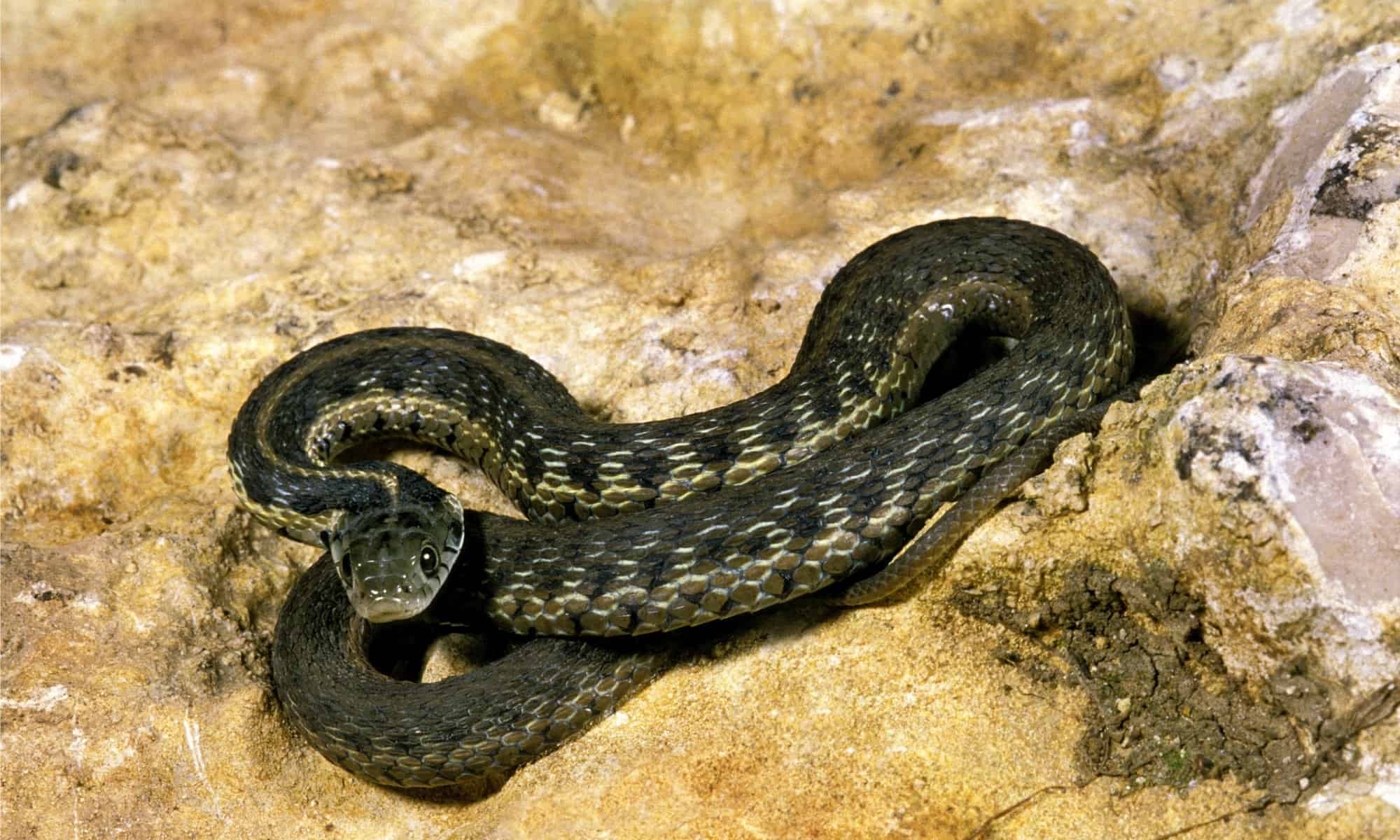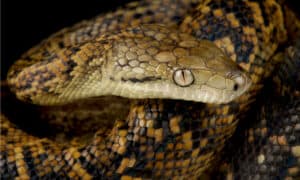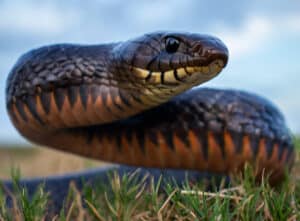As one of the most geographically diverse states in the United States, Oklahoma is made up of flat grasslands, forests, marshlands and mountain ranges. The diverse landscape is home to abundant wildlife, including snakes. Garter snakes count themselves among over 40 other species of snakes that are at home in this state. Let’s have a look at garter snakes in Oklahoma and find out which species live here, how to identify them and where in the state they reside.
Are Garter Snakes Venomous?
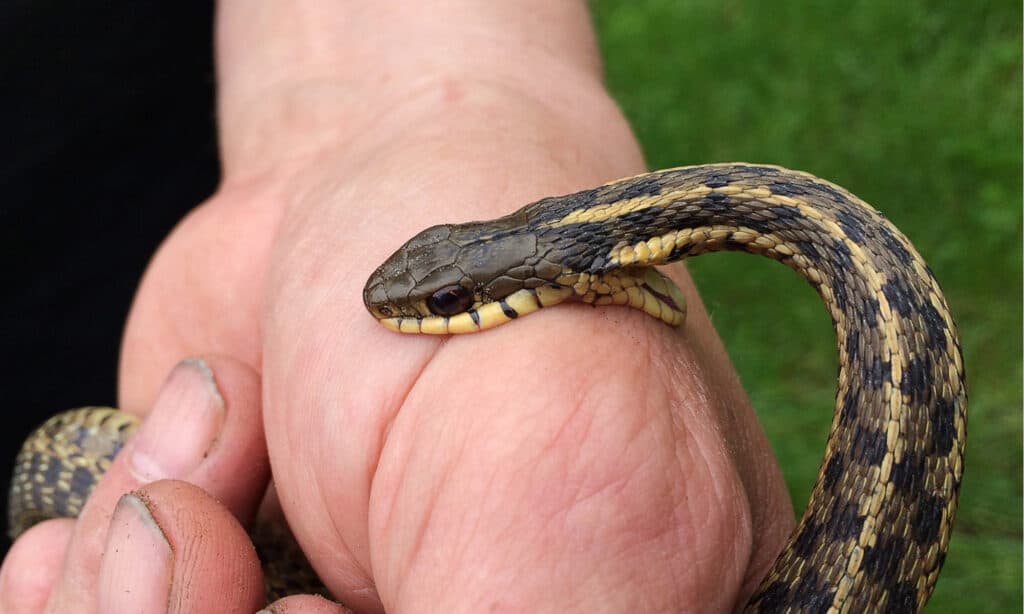
Garter snakes in Oklahoma are not harmful to humans, they are considered mildly venomous snakes whose venom subdues prey but doesn’t affect humans.
©mr.kie/Shutterstock.com
For most, garters are a welcome sight. They contribute to the balance of their ecosystem and assist in keeping common garden pests at bay. Like most snakes, they’re shy and prefer to stay mostly out of sight. But are they venomous? Turns out, they are mildly venomous. Their venom is capable of subduing their prey but isn’t potent enough to be harmful to humans. They won’t bite unless provoked and their bites rarely break the skin. If picked up, they may thrash and secrete a foul-smelling musk as a deterrent.
Get Familiar with the Garter Snake
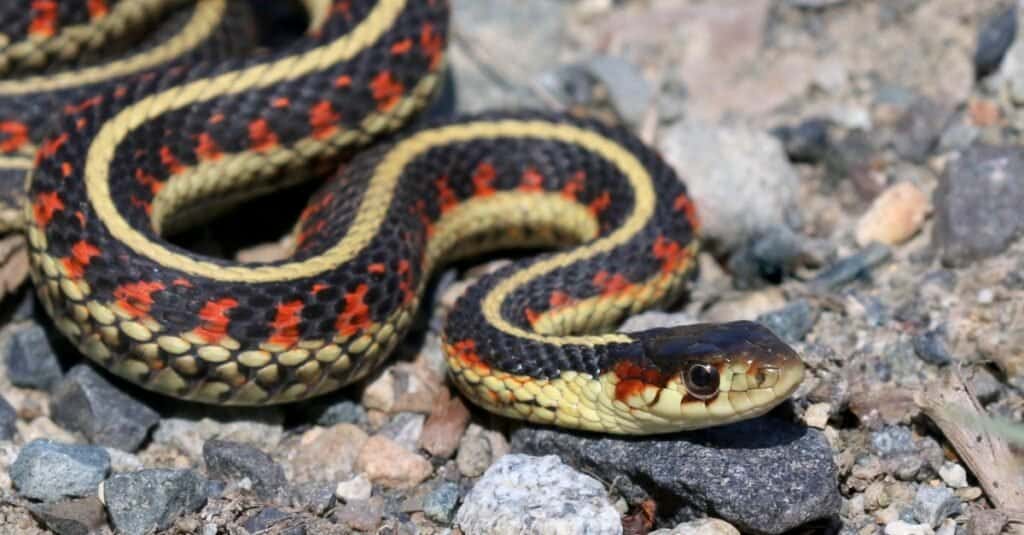
Most often found near water, garter snakes have adapted to live in many different environments.
©iStock.com/randimal
The garter snake is part of the Natricinnae subfamily. Most snakes in this group, including garter snakes, give birth to live young. The garter snake genus name Thamnophis is derived from the word thamnos for ‘bush or shrub,’ and ophio, meaning ‘snake.’ There are 35 species of garter snake. Like all snakes, they’re ectotherms, so their body temperature relies on environmental conditions. You might find garter snakes in shady areas in the heat of the day or sunning themselves on rocks when they need to warm up.
Garters are opportunistic snakes that have adapted to thrive in a variety of habitats and eat an assortment of prey types. You can find them living in woods, open fields, plains, and brush-filled areas with plenty of cover. They usually prefer to live near water. You might see garters at the edges of rivers, streams, ponds, and lakes. They often bask in the sun on woodpiles, hedges, and rocks. Garter snakes eat amphibians like frogs, toads, and salamanders. They will also eat other small prey like earthworms, mice, small fish, slugs, insects, and even small snakes. These snakes grow to be 18 to 48 inches on average, with some species reaching a maximum of 54 inches at times.
Garter Snakes In Oklahoma

There are over 40 nonvenomous snake species, including 5 types of garter snakes in Oklahoma.
©iStock.com/Brent_1
There are 7 potentially dangerous snake species in Oklahoma. Garter snakes are among more than 40 types of nonvenomous snakes in this region, including rat snakes, blind snakes, hognose snakes, and water snakes. Garter snakes are highly adaptable and can often thrive in suburban and urban areas. This is in part due to their ovoviviparity, or method of giving live birth. They don’t need a safe space to lay eggs, which gives them more flexibility in terms of habitat.
Garters are cold-tolerant snakes that are generally active earlier in the spring and later in the fall than many other snakes. However, they’re still most likely to be out and about when the weather is warm. They’re diurnal and typically solitary, coming out in the morning to bask in the sun and to hunt midday. They go into a period of inactivity called brumation at the coldest point of the year. During this time they’ll tuck themselves in crevices, under rocks, in trees or in dens on the banks of streams. At times, they’ll find themselves trapped in buildings when seeking out a warm shelter.
Which Garter Snake Species live in Oklahoma?
There are 5 garter snake species that live in Oklahoma:
- Common Garter Snake (Thamnophis sirtalis)
- Red-sided Garter Snake (Thamnophis sirtalis parietalis)
- Texas Garter Snake (Thamnophis sirtalis annectens)
- Western Terrestrial Garter Snake (Thamnophis elegans)
- Wandering Garter Snake (Thamnophis elegans vagrans)
- Checkered Garter Snake (Thamnophis marcianus)
- Marcy’s checkered Garter Snake (Thamnophis marcianus marcianus)
- Western Ribbon Snake (Thamnophis proximus)
- Plains Garter Snake (Thamnophis radix)
Common Garter Snake
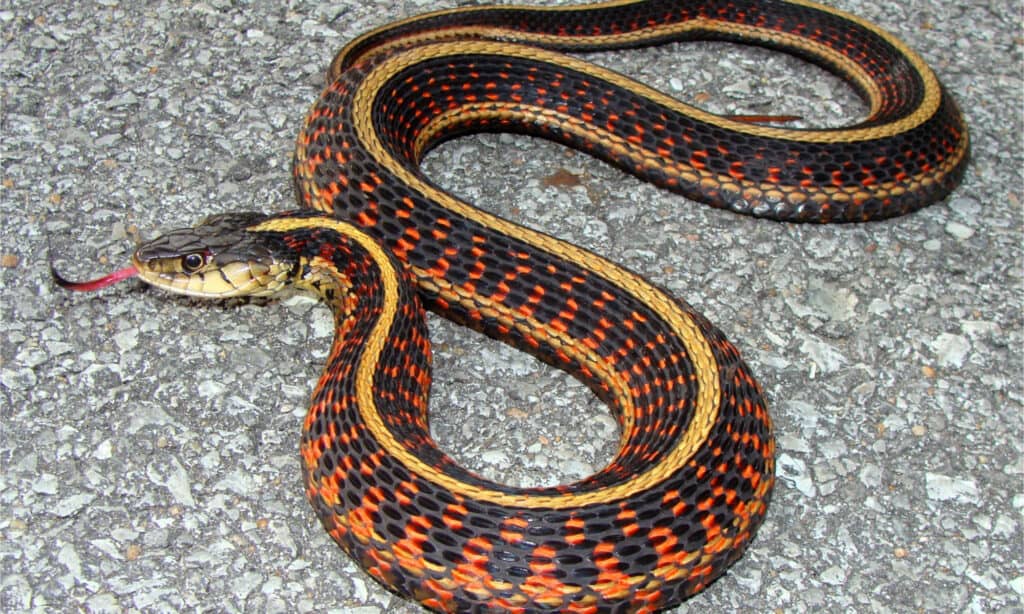
The red-sided garter is a subspecies of the common garter found in Central and Eastern Oklahoma.
©Matt Jeppson/Shutterstock.com
Common garter snakes can be found in damp woodlands, marshes, meadows, farmland and wooded parks, as well as backyards. You will typically find them near a water source. They have a thick dorsal stripe down their back that is usually yellow but can vary to reddish-orange. There are thinner yellow stripes on either side with black checkered markings between the stripes.
A subspecies of the common garter that lives in Oklahoma is called the red-sided garter. This is due to the red coloration on their sides between the stripes. These snakes can be found in Central and Eastern Oklahoma. The Texas garter snake is a brightly colored subspecies featuring thick lateral stripes that are also found in the state.
Western Terrestrial Garter Snake
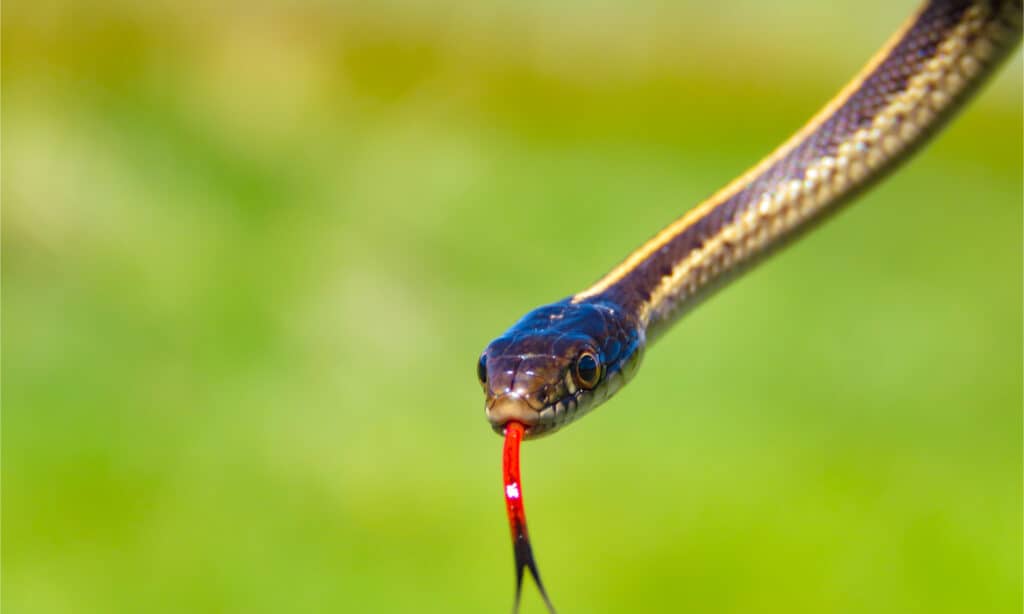
The western terrestrial garter is uniquely adapted to constrict its prey.
©Hunter Kauffman/Shutterstock.com
Like the common garter, the western terrestrial garter snake likes to live near bodies of water. This garter snake species is unique in its habit of constricting its prey. It’s the only garter that employs this method to feed. The Journal of Herpetology presented a study that showed that they were inefficient constrictors relative to gopher snakes but nearly always killed the mice they constricted before eating them.
The wandering garter is a subspecies of the western terrestrial garter snake found only at the westernmost tip of Oklahoma. It has a thin, dull yellow dorsal stripe that usually has black blotches along it. This gives the stripe a broken appearance. The body of this subspecies is generally gray or tan.
Checkered Garter Snake (Thamnophis marcianus):
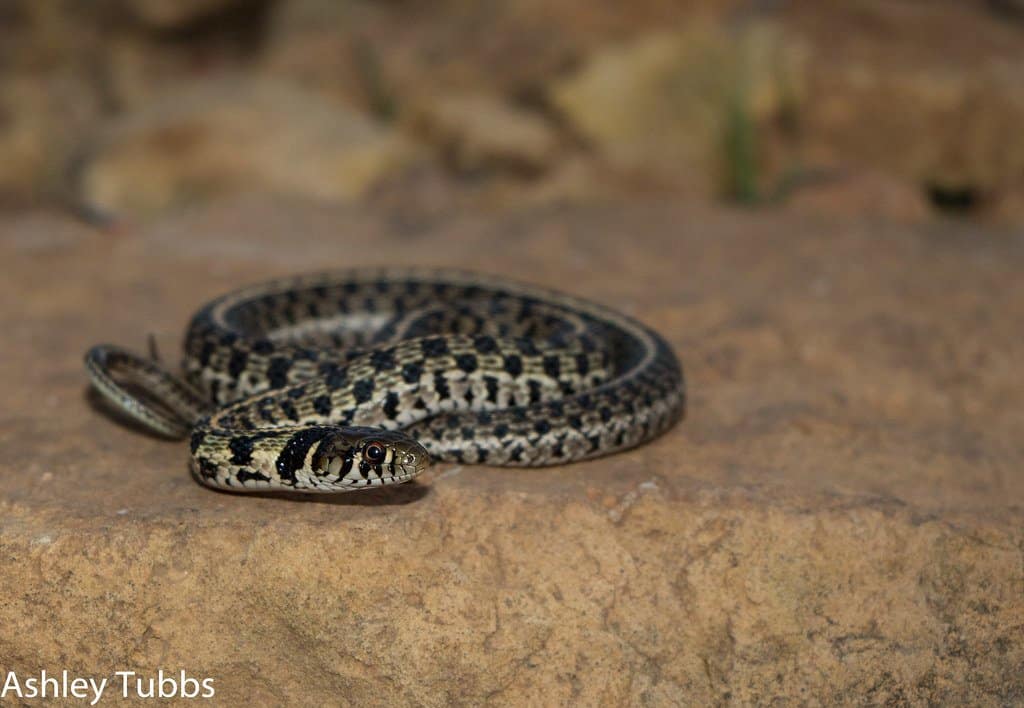
Checkered garters live in the western portion of the state.
©
These snakes have olive, tan, brown, or yellow-brown body coloration and three thin stripes. The dorsal stripe is often crowded by black spots beside it, giving it a jagged look. Checkered garter snakes have a cream-to-yellow belly. Their name comes from the checkerboard pattern of two rows of alternating dark rectangles between their stripes.
This species is most often found living in the western part of Oklahoma in deserts and grasslands. Like other garters, they like to be near water so you might find them near rivers, lakes, and streams. They are skilled at finding water sources even in the most arid of environments. Marcy’s checkered garter snake is a subspecies of the checkered garter that’s found in Oklahoma. This snake is common in the exotic pet trade, with the albino morph coloration being very popular.
Western Ribbon Snake (Thamnophis proximus):
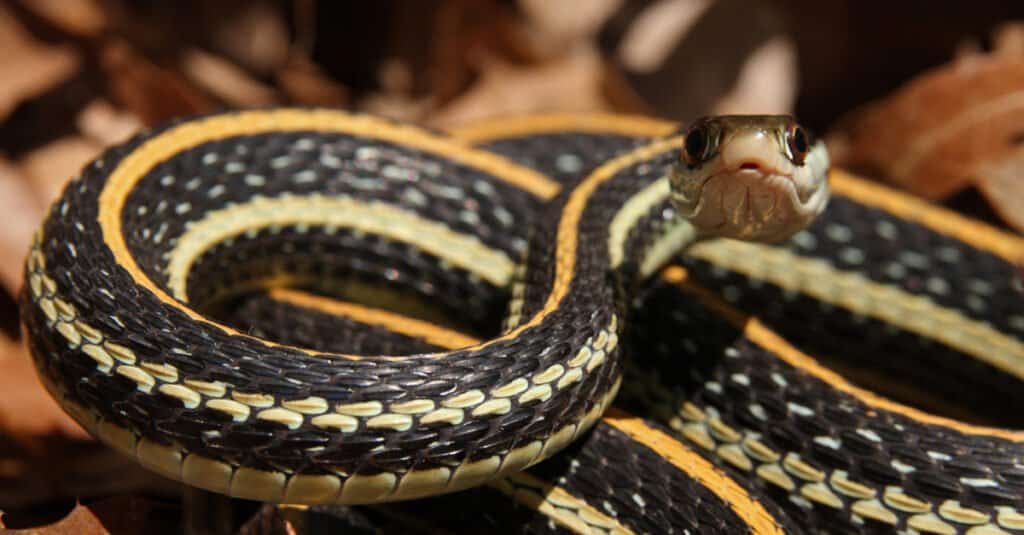
The western ribbon snake is a garter with a distinct vertical white bar in front of each eye.
©Ryan M. Bolton/Shutterstock.com
The western ribbon snake is another garter found in Oklahoma. They’re slender snakes of black, brown, or olive with three light-colored stripes down their bodies. Usually, the dorsal stripe is yellow near the head and changes to orange at the tail, but sometimes it’s all yellow. They sometimes have a checkerboard pattern between the stripes. They have white bellies that are sometimes greenish or yellowish. Western ribbon snakes have a distinctive vertical white bar in front of each eye.
These garters almost always live near water. They live near ponds, marshes, rivers, and lakes. These are fast snakes, but if they are caught they’re more likely to thrash about and expel musk than they are to bite.
Plains Garter Snake (Thamnophis radix)
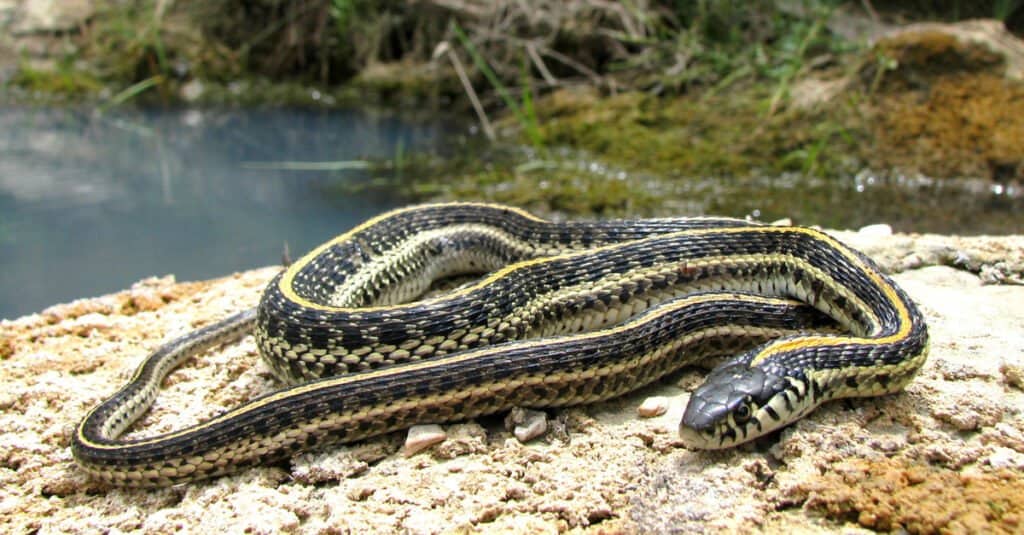
Plains garters have unique black bars around their mouth.
©Joe Farah/Shutterstock.com
The species has olive green, brown, or black bodies with an orange or yellow dorsal stripe down their back. Plains garters also have two greenish-yellow stripes on each side of their body. The areas between the stripes generally have an alternating double row of black spots. This snake has unique black bars around its mouth. Although garter snakes don’t pose a threat to humans, this species is known to be particularly docile and is less likely than the common garter snake to bite when handled. However, like other garters, it may secrete a strong musk as a deterrent.
Discover the "Monster" Snake 5X Bigger than an Anaconda
Every day A-Z Animals sends out some of the most incredible facts in the world from our free newsletter. Want to discover the 10 most beautiful snakes in the world, a "snake island" where you're never more than 3 feet from danger, or a "monster" snake 5X larger than an anaconda? Then sign up right now and you'll start receiving our daily newsletter absolutely free.
Thank you for reading! Have some feedback for us? Contact the AZ Animals editorial team.

